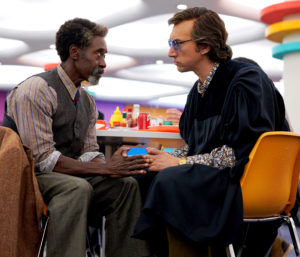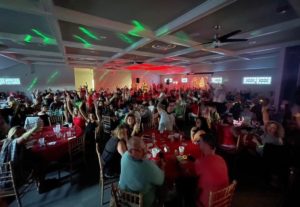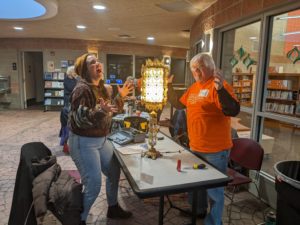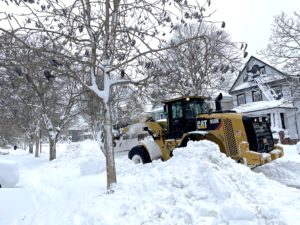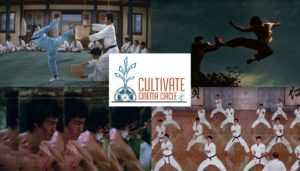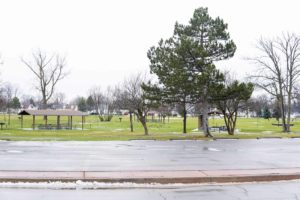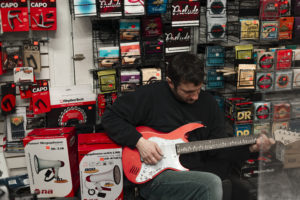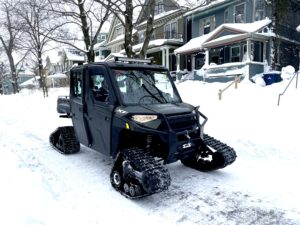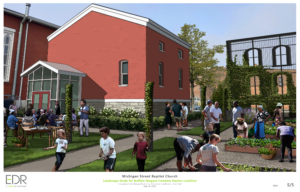What if death were noise?
Bored or stressed. That’s one way to understand the dichotomy at the core of Oscar-nominated director and writer Noah Baumbach’s worthy film treatment of Don DeLillo’s iconic postmodern novel, “White Noise,” published in 1985. The boredom in this case isn’t of the don’t-want-to-get-out-of-bed variety. It’s the boredom of cacophony, of a surfeit of the trivial, of consumerism (the glitter and meaningless variety of the supermarket), of the ignorance and barely controlled chaos of the family (“the cradle of the world’s misinformation”—precursor to social media’s role)—in a word, “noise.” The stress isn’t of the ordinary variety, either. It’s the stress of the existential: the fear of death, or the fear of the fear of death, that haunts human beings in any age. And boredom and existential anxiety aren’t as separate and distinct as they might seem: “What if death were noise”? asks Jack.
Occupying the bored/stressed purgatory are Jack (Adam Driver) and Babette (Greta Gerwig, Oscar-nominated director of “Lady Bird” [2107] and Baumbach’s partner and frequent collaborator) and their large, blended family, a product of several divorces—a bunch of know-it-all, bossy, irritating, sometimes prescient, sometimes out-of-control children (“where’s Wilder”?). Babette, who teaches “movement” to old folks, is presumably the stable, “joyous” element. Jack offers courses on “Advanced Nazism” at College-on-the-Hill, surely an ironic reference to John Winthrop’s 1630 sermon that characterized the Massachusetts Bay colony as a shining example to the world, “a city upon a hill.”
The blended family in distress, led by Jack (Adam Driver). Left to right, Babette (Greta Gerwig) holding Wilder (Henry or Dean Moore), Steffie (May Nivola), Heinrich (Sam Nivola), and Denise (Raffey Cassidy).
Their project—holding things together, accepting the “white noise” of daily life as a shield against the darkest of truths—works, until a toxic cloud appears on the horizon, a reminder of the 1979 meltdown at Pennsylvania’s Three Mile Island nuclear power plant. Jack, especially, is in denial (“it won’t come this way”), the children intrigued but anxious. The family’s flight partakes of reality—the cloud’s threat is apparently real, if unknowable—but also of comedy and farce and violence (signs that Jack, and the family, have lost their grip on whatever it was that kept them sane), with a touch of 1984 (when the book is set) bureaucratic-speak: “We have a situation,” notes a worker at Camp Daffodil, an emergency refuge center. The flower is the symbol of rebirth and new beginnings.
Following the book and a recent cinema industry trend, Baumbach’s script is organized into three chapters. The title of the first, “Waves and Radiation,” bears no relationship to its content (except possibly to television and radio); it’s essentially a description of the day-to-day challenges of life under “white noise.” The third chapter, “Dylarama,” derives from the name of an unapproved drug (and of the spectacle, as in Cinerama) to which Jack and Babette are attracted, because it promises relief from the anxiety of one’s eventual demise. Packed with madcap antics and a less-than-credible sequence involving a gun, this is the least satisfying and most problematic of the chapters, though the heretical German nuns provide a nice touch of black comedy.
It’s the second chapter, “Airborne Toxic Event,” that matters. Until the toxic cloud, there is no plot, and it’s “plot” that Jack seeks to avoid. In the parlance of postmodernism, plot means planning, and planning means projecting oneself into the future—toward the inevitable end. “All plots,” proclaims Jack in a lecture on the plot to kill Hitler, “tend to move deathward.” That’s how Jack sees it—he’s moving deathward—and Driver, sweaty and leaking angst from every pore, plays the part to perfection: low affect, no histrionics, just a man in crisis, losing control. Already the recipient of several Oscar nominations, Driver may have delivered his best performance yet. Gerwig’s Babette, stolid and even wooden as the family rock, stands in contrast to her husband’s growing panic. Then she too succumbs, revealing to Jack, to whom she’s proclaimed earlier that she wants to die before him: “My fear of death is greater than my love for you.”
Jack’s colleague at the college, Murray (an energetic, entertaining Don Cheadle, 2004 Best Actor Oscar nominee for “Rwanda”), offers another perspective, one more life-affirming. But he, too, can’t resist the ostensibly trivial, suggesting that Americans love car crashes because they exude optimism, and that what academia needs is a study of the “culture of public toilets.” He joins Jack in a “brilliant” but ultimately simplistic classroom session in which Hitler and Elvis are revealed to be the products of over-mothering. At times it can seem as if Murray knows more about life than Jack, but his authority comes into question when he explains to Jack that there are “diers” and “killers,” and that it’s possible to “kill death.” Jack actually tries to do that.
DeLillo could hardly have anticipated the information overload/white noise of the Fox News/social media/QAnon era, or the damage unchecked capitalism would do in the next decades, enriching the already wealthy while failing to distribute profits even faintly equitably. But he was not alone in understanding the corrosive amorality that characterized Reagan-era economics. “Money for nothin’, chicks for free” was Dire Straits’ 1985 refrain; Madonna said it just as well in her 1984 hit: “You know that we are living in a material world/And I am a material girl.” In the final, Bollywood-like scene of “White Noise,” presented over the credits, shoppers at the A & P lovingly fondle pineapples and dance enigmatically in the aisles as they pick goods off the shelves. “We keep inventing hope,” Jack laments as he enters the store with his brood, “and this is where we wait.” It’s a dance of the about-to-be (and perhaps already) dead—victims not of the toxic cloud, but of “white noise.”
Date: 2022
Stars: 3.5 (out of 4)
Director: Noah Baumbach
Starring: Adam Driver, Greta Gerwig, Don Cheadle
Country: United States
Language: English and some German (subtitled in English)
Runtime: 136 minutes
Other Awards: 1 win and 19 nominations
Availability: Except for the occasional second-run or art-house theater, streaming only on Netflix after a brief theater run; see JustWatch here for possible future expanded streaming possibilities.
Lead image: Don Cheadle, left, as Murray, who teaches optimism, among other topics, at College-on-the-Hill with Jack (Adam Driver).
See all Five Cent Cine reviews by 2 Film Critics
The post Five Cent Cine: White Noise appeared first on Buffalo Rising.

